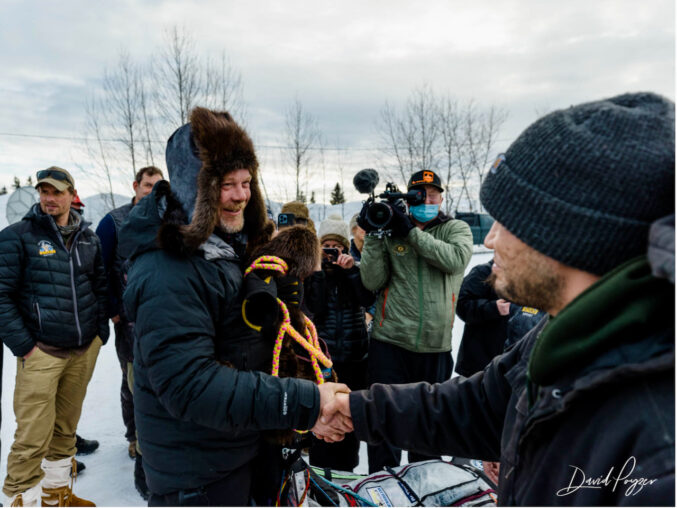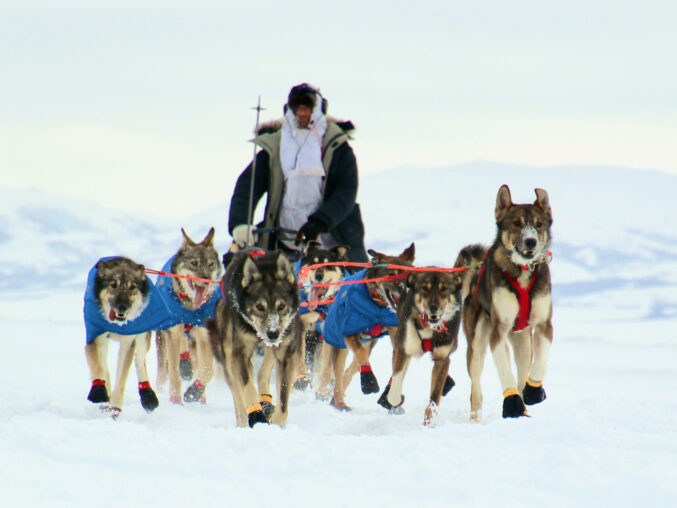Brent Sass claimed another “first to” award late last night when he arrived in Unalakleet at 23:32. The Ryan Air Gold Coast Award is his fourth award of the race along with the Halfway Award at Cripple, First to the Yukon Award at Ruby, Fish First Award at Kaltag and Gold Coast Award at Unalakleet. Aaron Burmeister claimed the Spirit of Alaska Award presented by Alaska Air Transit for being the first to McGrath.

Alaska Air Transit Spirit of Alaska Award Goes to Aaron Burmeioster of Nome (Photo Credit Dave Poyzer)
Looking back in the archives, I wanted to see how many times the first musher to make the gold coast went on to claim gold in Nome. Trying to make all things equal, I looked at the northern route races for the past twenty years. It’s a 40/60 split. Four mushers have earned gold in both places but 6 have turned out to be different. Buser in 2002, King in 2006, Lance Mackey in 2010 and Thomas Waerner in 2020 are the people who have been first to the coast and also first to Nome. Here’s the list for the 60% that were different – 2004 Kjetil Backen coast, Mitch Seavey Nome; 2008 Jeff King coast, Lance Mackey Nome; 2012 Aliy Zirkle coast, Dallas Seavey Nome; 2014 Aliy coast, Dallas Nome again; 2016 Brent Sass coast, Dallas Seavey Nome; 2018 Nicolas Petit coast, Joar Leifseth Ulsom Nome. Draw your own conclusions here but being first to the coast is no guarantee the same will be true in Nome.
Cripple checkpoint has bid farewell to its final musher, Lisbet Norris and her Siberians. Lisbet departed Cripple at 04:14 this morning and is following Kailyn Davis, Yuka Honda and Apyauq Reitan to Ruby. The word from Ruby is WIND! Dave Poyzer and other Insiders are patiently waiting for mother nature to dial down the fan speed so they can fly on down the trail.
Winds have been a problem on the run from Kaltag to Unalakleet and then up the coast. When Brent Sass arrived in Unalakleet he stayed long enough to accept the Ryan Air Award, thank Ryan Air for their support of the race, grab necessary supplies from his drop bags and depart for a sheltered spot to camp in the Blueberry Hills a few miles further down the trail. After taking his 8 hour Yukon rest at Kaltag, Sass camped at the Old Woman Cabin located 2/3 of the way from Kaltag to UNK.
Seavey on the other hand, took his rest at Nulato, went through Kaltag and camped at Tripod Flats about 1/3 of the way into the Kaltag Portage trail. When he arrived in Unalakleet he stayed for 3 and a quarter hours. Likely he hunkered down behind the snow berms that are piled up for windbreaks.
There are fifteen mushers on the trail between Kaltag and Unalakleet so no better time than the present to share a little history about Kaltag and the trail running to the coastal community of Unalalkleet.
Kaltag is an Athabascan village that sits on an old portage trail that went west from the Yukon through the mountains to Unalakleet (YOU-na-la-kleet). Sadly, disease and death have played a great role in Kaltag’s history. Originally, Kaltag was an area used as a cemetery for surrounding villages. Athabascans had spring, summer, fall and winter hunting and fishing camps in the area and moved according to where the game or their food source was. Then in 1839 a small pox epidemic killed many of the natives and traders in the area. In 1880 a trading post opened and then a few years later gold was discovered. In 1900, a measles epidemic and food shortage wiped out nearly one-third of the area’s population. It was then that the survivors from 3 nearby seasonal villages decided to move together and form a new village. Kaltag was named for a Yukon Indian, Kaltag. Between 1919 and 1940, the Galena lead mines were prosperous. Kaltag, 100 miles downriver, grew as a transportation hub. Over time as the mighty Yukon flooded and changed its course, land eroded and the old cemetery slid into the river in 1937.
The trail from Kaltag to Unalakleet follows a portage trail used by the Athabascans of the interior to travel to the Bering Sea Coast to trade with the Inupiaq. Russians also used the trail in their explorations and trading activities. Just 15 miles out of Kaltag, the mushers climb to 800 feet above sea level at the summit of the portage through the Nulato Hills. In Iditarod Trail Notes, Don Bowers warns the mushers that ground blizzards and other storms can blow up in a minute on the western side of the summit. There are a couple of Bureau of Land Management (BLM) cabins on the way to UNK. One is in the Tripod Flats and the other is near the Old Woman River. Basic bush etiquette requires that any firewood used at cabins like this be replaced before leaving. If a team stays at the Old Woman Cabin, the musher must leave some food. Legend has it that unless you leave her something, the old woman’s ghost will chase you to Nome and bring you bad luck.
Once past the Old Woman Cabin, mushers may be able to see the Unalakleet airport beacon flashing green then white at night. This is a good sign as it means it’s not snowing on the rest of the trail to UNK. It’s interesting that early airmail pilots used to fly in all kinds of weather using beacons like this to find their way. The closer a team gets to UNK, the more likely they will encounter blowing and drifting snow.
The community of Unalakleet lies between the homelands of two indigenous culture groups. The Inupaiq live to the north and the Yupik live to the south. With its trees, tundra and hills, Unalakleet is a very beautiful place. It’s on the Bering Sea next to the large clean Unalakleet River. Being known for its fishing and scenery, tourists often visit Unalakleet.
It’s an understatement to say this is a tight race. It’s one that has you on the edge of your chair while studying the race stats sheet and watching the GPS Tracker. Aaron Burmeister is running a pretty solid third right now. There’s likely to be some leap frogging between 4th thru 10th place and some of those mushers may be challenged by the strong contestants running 11th thru 15th. The top 10 places of this race could be greatly influenced by the ultimate force of Mother Nature.



































